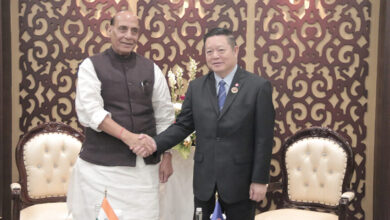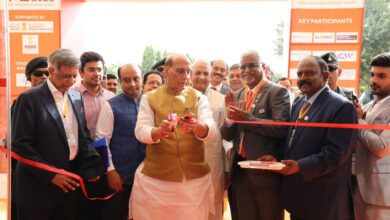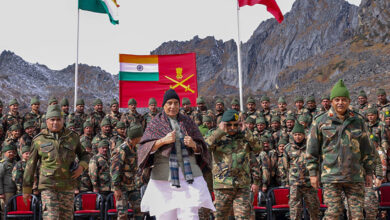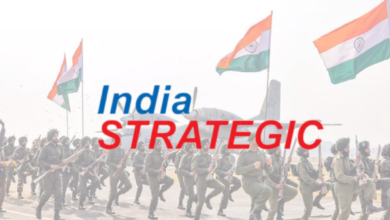RAFALE: The True Blood French Fighter

French Dassault Rafale jet fighter, 36 of which the Indian Air Force (IAF) is aspiring to acquire to meet part of its MMRCA requirements can easily be termed as a true blood French aircraft as not only the airframe but all other systems and sub-systems fitted on the aircraft have been developed and manufactured within France by French defence companies.
Interestingly, in the late 1970s, France was part of consortium of four other European nations which were getting together to pool in their resources to produce an agile multi-purpose European fighter. However, soon disagreements appeared over work- share and differing operational requirements which led to France going solo in pursuing its own fighter programme, while the other four nations namely; the UK, Germany, Italy and Spain continued with the joint European programme. Their respective endeavours resulted in the creation of what came to be known as the Eurofighter Typhoon and the French Dassault Rafale.
Notably, both these were the two short- listed fighters in a hotly contested six-cornered competition that also included Boeing F-18 Super Hornet and Lockheed Martin F-16’s latest model, the Russian F-35 and the Swedish Saab Gripen NG for India’s MMRCA programme. Eventually, it was the Rafale which emerged as the ultimate winner narrowly beating the Eurofighter in the final run in.
The Rafale – literally meaning a ‘Gust of Wind’ or a ‘Burst of Fire’ in a more military parlance – turned out to be a 4th generation+ multi-role aircraft capable of performing varied tasks such as air superiority, counter air and interdiction, aerial reconnaissance, deep precision strikes, anti-ship strikes and nuclear deterrence missions.
A delta-wing design combined with active close-coupled canard and digital fly-by- wire flight controls have resulted in a highly manoeuvrable aircraft which can easily operate within a g-envelope of -3to+9g (11g permissible in emergency). The aircraft canards also act to help aircraft perform well at slow speeds. Dassault has in fact proved through simulations that the aircraft has sufficient slow speed performance to be able to operate from STOBAR configured aircraft carriers (such as the Indian Navy’s INS Vikramaditya and under-construction INS Vikrant), even though Rafale in its naval ‘M’ version is equipped to operate from CATOBAR carriers, thus providing considerable flexibility to the navies, equipped with both types of aircraft carriers.
Notably, Indian Navy would fall in this category should it opt for CATOBAR operations (in all probability General Atomic EMALS) for its futuristic 65,000-tonne class aircraft carrier, to be named INS Vishal.
Although deliberately not designed as an all-aspect stealth aircraft due to excessive costs, copious use of composite materials and serrated patterns for the construction of trailing edges of the wings and canards has resulted in markedly reduced radar cross-section (RCS) and infrared signature, which has deservedly put the Rafale in the Gen 4+ class of jet fighters.

Rafale has proven to be a worthy successor to Mirage 2000, which by itself was a highly capable aircraft that will continue to serve the IAF as one of its most potent frontline fighters – especially so after the upgrades. And, as stated earlier, Rafale is almost entirely built by just one country, involving most of France’s major defence contractors that apart from the parent Dassault include Safran (for power plants), Thales (for avionics), and MBDA (for major weapon systems).
For Example, two Safran (Snecma) M88-2 engines power the Rafale with each engine capable of providing up to 50 kN (11,250 lbf) of dry thrust and 75 kN (16,900 lbf) with afterburners. The engines feature several advances, including a non-polluting combustion chamber, single-crystal turbine blades, powder metallurgy disks, and technology to reduce radar and infrared signatures.
The M88-2 enables the Rafale to super- cruise while carrying four missiles and one drop tank.
On the avionics front, it’s mainly Thales with some components from SAGEM that make up for the various systems and sub-systems fitted on the aircraft. The Rafale core avionics systems employ an integrated modular avionics (IMA), called MDPU (modular data processing unit). This architecture hosts all the main aircraft functions such as the flight management system, data fusion, fire control, and the man- machine interface. The IMA greatly assists combat operations via data fusion, the continuous integration and analysis of the various sensor systems throughout the aircraft, and has been designed for the incorporation of new systems and avionics throughout the Rafale’s service life.
Thales RBE2 AA active electronically scanned array (AESA) radar has replaced the previous passively scanned RBE2. The RBE2 AA has a greater detection range of 200 km, improved reliability and reduced maintenance demands. In addition, to enable the Rafale to perform in the air supremacy role, Rafale sports several passive sensor systems. For example, the front- sector electro-optical system or Optronique Secteur Frontal (OSF), developed by Thales, is completely integrated within the aircraft and can operate both in the visible and infrared wavelengths. The OSF enables the deployment of infrared missiles such as the MICA at beyond visual range distances; it can also be used for detecting and identifying airborne targets, as well as those on the ground and at sea. The OSF is immune to jamming and capable of providing covert long-range surveillance.
For self-defence, the Rafale features an integrated defensive-aids system named SPECTRA, which protects the aircraft against airborne and ground threats, developed as a joint venture between Thales and MBDA. The system has been designed to be highly re-programmable for addressing new threats and incorporating additional sub-systems in the future. Operations over Libya were greatly assisted by SPECTRA, allowing Rafales to perform missions independently from the support of dedicated Suppression of Enemy Air Defences (SEAD) platforms.
The Rafale’s precision strike capability is heavily reliant upon sensory targeting pods, such as Thales Optronics’s Reco New Generation/ Areos reconnaissance pod and Damocles electro-optical/laser designation pod. Together, these systems provide targeting information, enable tactical reconnaissance missions, and are integrated with the Rafale’s IMA architecture to provide analysed data feeds to friendly units and ground stations, as well as to the pilot. Damocles provides targeting information to the various armaments carried by the Rafale and is directly integrated with the Rafale’s VHF/UHF secure radio to communicate target information with other aircraft. It also performs other key functions such as aerial optical surveillance and is integrated with the navigation system as a FLIR.
Notably, the total value of the radar, electronic communications and self-protection equipment works out to about 30 per cent of the cost of the entire aircraft.
The Armament and weapons too clearly carry a French stamp as far as the Rafale is concerned, most having come from the MBDA arsenal. For example, for air defence/ air superiority missions F3 standard Rafales can carry dual-use MICA (IR and radar guided versions) and Meteor (long range, active radar terminal homing) air-to-air missiles, both MBDA products. For precision ground strikes, Rafales can be armed with Apache, Brimstone and Storm shadow/SCALP-EG air-to-surface missiles. For nuclear deterrence the Rafale carries the MBDA’s ASMP nuclear missile. In the maritime strike role, the Rafale carries the advanced air-launched version of AM-39 Exocet sea-skimming missiles.
The IAF has yet to select the weapons for its Rafale fleet, but undoubtedly, most of these would be the already cleared weapon systems from MBDA. It could later decide whether it would integrate some home-grown weapons such as the air-launched Brahmos, if possible (presently, because of its considerable dimensions and weight only Su-30 MKI can carry this weapon and that too only on the under-fuselage centerline station) and the still to be perfected indigenous Astra BVR air-to-air missiles, and so on.
It would be obvious that with the induction of Rafales the IAF would be able to greatly regain/augment its combat capabilities. But clearly, acquisition of just 36 aircraft would be inadequate to meet the emerging challenges of a possible two-front scenario. IAF Chief, Air Chief Marshal Arup Raha has emphasized the need for the IAF to acquire at least 100 more MMRCA aircraft but how this need would be met is yet to be seen.





